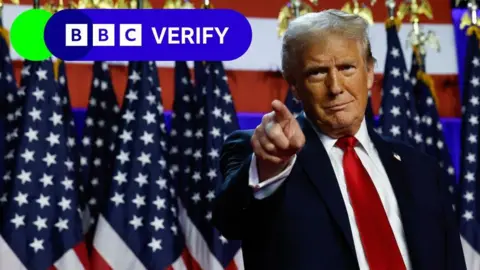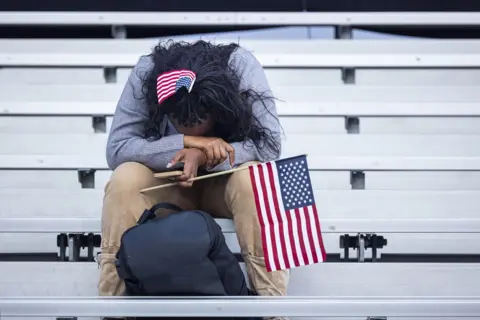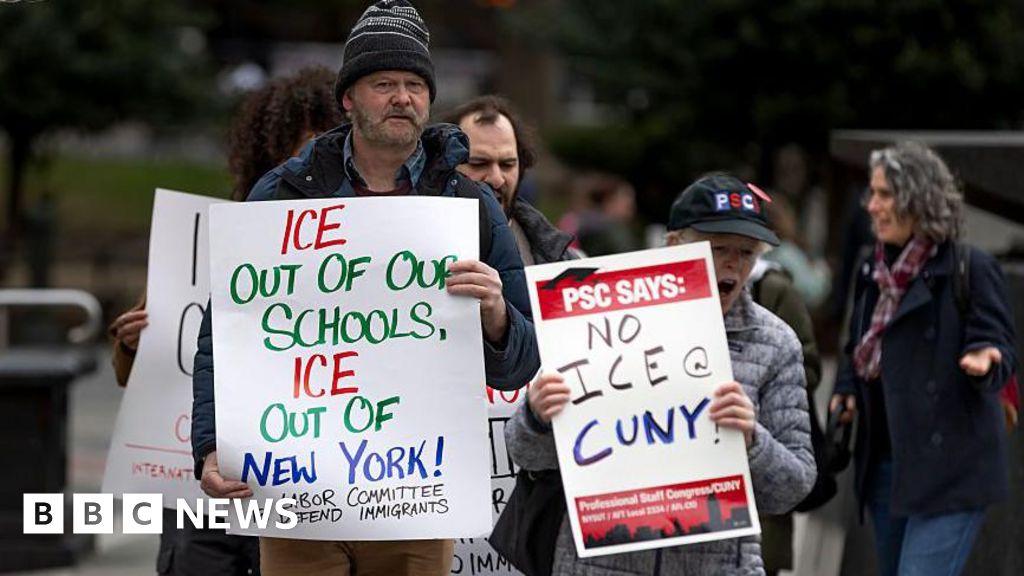ARTICLE AD BOX

 Getty Images
Getty Images
Donald Trump addressed supporters in the early hours of Wednesday after the election results became clear
In the build-up to Tuesday’s US election, claims of voter fraud flooded social media - but as Donald Trump’s victory crystallised, the chatter largely subsided.
The claims didn’t stop entirely, however. A number of right-wing influencers and organisations pushing stories about “cheating” and a “rigged” vote pointed to incomplete vote totals and continued to repeat discredited theories about the 2020 election.
And disappointed Democratic Party supporters developed their own unsubstantiated voter fraud theories, some of which went viral on X, formerly Twitter, and other platforms.
The reach of the posts is nowhere near the deluge of content that circulated after Trump lost the 2020 election.
And with no support from losing candidate Kamala Harris or other Democratic Party officials, the chances seem slim of a large-scale movement developing along the lines of the “Stop the Steal” drive four years ago, which culminated in a riot at the US Capitol.
How did fraud claims develop on election day?
The BBC tracked a huge wave of pre-election fraud claims that carried through election day and into the evening.
These included claims of the vote being “stolen” in some key swing states, with exaggerated takes on real events being used in some cases to bolster the allegations.
Early on election day in Cambria County, Pennsylvania, a Republican stronghold, there were problems with voting machines malfunctioning. The issues were fixed and voting hours in the affected areas were extended.
However, many online immediately used the story to suggest nefarious activities were taking place.
One post at 08:45 local time on Tuesday said: “The election steal is happening!”
Other rumours were spread in posts that popped up throughout the day, including one at around 14:00, which claimed ballots in Delaware County, Pennsylvania, had been pre-marked for Kamala Harris.
In Milwaukee, the biggest city in the swing state of Wisconsin, elections officials made a decision to re-run around 30,000 ballots out of an “abundance of caution”, after doors on the back of voting machines were left open.
Once the count was completed, it showed that support for Harris had dropped compared with Joe Biden's four years earlier.
Like many of the pro-Trump posters, Harris supporters pointed to real but isolated events - fires at ballot drop boxes in Washington and Oregon, and a series of fake bomb threats that disrupted voting at several polling locations on election day - as evidence of widespread voter fraud.
However, there’s no evidence that the incidents significantly altered the vote or changed the outcome.
Several posts from Democratic Party activists questioning the result went viral and were seen by millions on X and other platforms.
Pam Keith, a Harris supporter in Florida, posted: “Is it possible that the machines were hacked to switch the tallies from Harris to Trump?” Her message was seen more than one million times on X, according to the site’s metrics. The BBC has reached out to her for comment.
Unlike Trump’s campaign in 2020, however, the Harris campaign and top Democratic Party officials have not endorsed allegations of cheating or voter fraud.
On election day, fraud rumours also came from President-elect Trump himself, who has repeatedly argued from the outset of his political career that the voting system is unfairly stacked against him.
Just after 16:30 Trump posted on his social media platform Truth Social: “A lot of talk about massive CHEATING in Philadelphia. Law Enforcement coming!!!”
The now president-elect did not give any details and the Philadelphia Police Department told BBC Verify they were not aware of what Trump was referring to.
Seth Bluestein, the Republican City Commissioner in Philadelphia, posted on X: "There is absolutely no truth to this allegation. It is yet another example of disinformation. Voting in Philadelphia has been safe and secure."
Trump has not repeated the fraud allegations since election day.
We have contacted several hugely influential accounts that regularly posted about election fraud claims in the build-up to the vote, but none of them replied.
With data firm NodeXL, the BBC tracked accounts that engaged with Donald Trump, Donald Trump Jr, Eric Trump, Lara Trump and Elon Musk on X around election day.
Posts mentioning vote fraud peaked at 15:00 EST on 5 November - but then dropped off significantly that evening and into the next day as polls closed and results came in.
Claims continue to circulate
However, some organisations and activists who promoted voter fraud allegations in the past continued to repeat debunked rumours even after the results became clear.
Emerald Robinson, a former reporter with right-wing TV networks and a pro-Trump influencer with more than 750,000 followers on X, insisted that Democrats were “cheating right now” and posted: “I always told people the voting machines were rigged!”
More generally, reaction from pro-Trump groups and influencers who previously hyped up vote fraud claims varied - from silence on the issue, to continued insistence that the 2020 vote was marred by fraud.
The BBC contacted Ms Robinson for comment.

 EPA
EPA
A dejected supporter of Kamala Harris. Some Democratic Party supporters have spread unevidenced claims in the wake of Harris's defeat
Conspiracy theories based on vote numbers
In another case, a chart that was widely circulating online claimed to show a sharp drop-off in vote totals in 2024 compared to 2020.
Many are pointing to the figures as “proof” of fraud.
Conservative commentator Dinesh D'Souza, a Trump supporter who has pushed voter fraud theories, posted the day after the election: "Kamala got 60 million votes in 2024. Does anyone really believe Biden got 80 million in 2020? Where did those 20 million Democratic voters go? The truth is, they never existed."
However, the chart and the figures circulating online were based on preliminary vote totals, which continue to go up as final results are still being tabulated.
Already, Harris has more than 69 million votes in her column - with Trump on more than 73 million. As of Friday, fewer than two million ballots have yet to be counted nationally, in states including Arizona and California, according to Reuters.
The BBC contacted Mr D'Souza for comment.
Those same numbers are also fuelling conspiracy theories from supporters of Harris, who are wondering where their “missing” voters are - and ignoring the fact that turnouts and preferences frequently shift, often dramatically, between elections.
Partisans on both sides are also pointing to differences in vote tallies for Harris and other Democrats running for Senate seats.
But there is no requirement for US voters to support candidates from just one party, and “ticket-splitting” - voting for candidates from different parties in different races - although becoming rarer, is fairly common in American politics.
The University of Florida’s Election Lab turnout tracker is showing slightly lower turnout in 2024 as compared to 2020 - 62.5% v just over 66%.
Additional reporting by Shayan Sardarizadeh and Merlyn Thomas



 5 months ago
22
5 months ago
22








 English (US) ·
English (US) ·